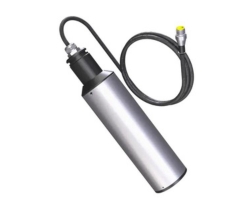A dissolved oxygen probe is a crucial tool in environmental monitoring, water quality assessment, and various scientific and industrial applications. It measures the concentration of dissolved oxygen (DO) in a liquid, typically water. This parameter is of paramount importance as it directly impacts aquatic life, biochemical processes, and the overall health of ecosystems. The probe operates based on the principles of electrochemistry and is designed to provide accurate and real-time measurements of dissolved oxygen levels in various environments.
various environments.
Working Principle: The working principle of a dissolved oxygen probe is rooted in the phenomenon of oxygen’s interaction with an electrode, often referred to as the oxygen sensor or oxygen membrane. The most common type of dissolved oxygen probe utilizes a Clark-type oxygen sensor, which involves a cathode and an anode separated by an electrolyte and a gas-permeable membrane. The cathode typically consists of a precious metal, often platinum, while the anode is typically made of silver. The electrolyte is usually an alkaline solution. The gas-permeable membrane allows oxygen molecules to diffuse from the surrounding liquid into the probe.
When the dissolved oxygen probe is immersed in a liquid, oxygen molecules from the liquid diffuse through the gas-permeable membrane and reach the cathode. At the cathode, oxygen molecules are reduced, and a reduction current is generated as a result of the electrochemical reaction. This current is proportional to the concentration of dissolved oxygen in the liquid. The anode, on the other hand, facilitates the transfer of electrons through the circuit.
The generated current is then measured by the probe’s electronics and converted into a dissolved oxygen concentration reading. The probe’s electronics often include a microprocessor that compensates for temperature variations, as dissolved oxygen solubility is influenced by temperature. Modern probes also come with features to minimize interference from other substances in the liquid, ensuring accurate and reliable measurements.
Applications: Dissolved oxygen probes find wide-ranging applications in both research and industrial settings. Some of the key applications include:
-
Aquatic Ecology and Environmental Monitoring: Monitoring dissolved oxygen levels in natural water bodies such as rivers, lakes, and oceans is vital to understanding the health of aquatic ecosystems. Low oxygen levels can lead to fish kills and harm other aquatic organisms, while excess oxygen can disrupt the balance as well.
-
Wastewater Treatment: In wastewater treatment plants, monitoring dissolved oxygen levels is crucial for ensuring the efficiency of aerobic biological processes that break down organic matter. It helps control aeration rates and prevents oxygen deficiency that can hamper the treatment process.
-
Aquaculture: In fish farming and aquaculture operations, maintaining optimal dissolved oxygen levels is essential for the health and growth of aquatic organisms. Probes help prevent oxygen-related stress or mortality.
-
Industrial Processes: Various industrial processes, such as fermentation, require precise control of dissolved oxygen levels to ensure desired product outcomes.
-
Scientific Research: Researchers use dissolved oxygen probes to investigate oxygen consumption rates, metabolic activity, and other biochemical processes in both aquatic and laboratory environments.
Conclusion: The dissolved oxygen probe is an indispensable tool for understanding and managing the oxygen content in liquids, especially in aquatic environments. Its electrochemical principles, gas-permeable membrane, and modern electronics combine to provide accurate and timely measurements of dissolved oxygen concentrations. This information serves as a vital parameter in various applications, spanning from environmental monitoring to industrial processes, ultimately contributing to the preservation of ecosystems, the advancement of scientific knowledge, and the optimization of industrial practices.

